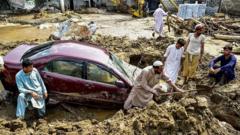In a tragic account of the recent monsoon flooding, officials in Buner district, north-west Pakistan, report that over 200 individuals remain unaccounted for as rescue efforts continue. The floods, exacerbated by severe monsoon rains, have claimed more than 300 lives across Pakistan and Pakistan-administered Kashmir, with the majority of fatalities concentrated in Khyber Pakhtunkhwa province.
Local authorities have confirmed that at least 209 people are still missing in Buner, leaving families with growing concerns as they grapple with the impact of this environmental disaster. Jehangir Khan, a spokesman for the deputy commissioner of Buner, relayed the harrowing news that eight unidentified bodies have been buried without relatives present to claim them. The destruction of roadways has impeded many families' ability to reach their loved ones.
Compounding the disaster, provincial rescue officials report that entire villages have been partially buried, with rescue teams facing immense challenges in reaching those in need. The devastation extends to nearby Shangla district, where numerous individuals are also reported missing.
Climate change has intensified the frequency and severity of monsoons, leading to increased instances of landslides and floods in the region. This year's monsoon season, which typically runs from June to September, has already seen over 650 fatalities, with Punjab province experiencing particularly heavy rainfall—73% more than the year prior.
The consequences of these extreme weather patterns are further exacerbated by the rapid melting of glaciers in northern Pakistan. Experts indicate that this glacial retreat dislodges soil and debris, increasing the risk of destructive landslides. As government forecasts predict ongoing heavy rainfall, the situation remains dire, with many parts of north-west Pakistan classified as disaster zones.
As floodwaters continue to rise and more regions face potential disaster, the overarching question remains: how can communities adapt and respond to the shifting climate realities that underpin such natural disasters?


















